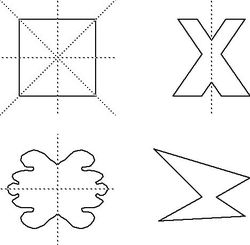Symmetry

Reflectional Symmetry is a property of certain geometrical objects that appears the same when mirrored or reflected along an axis. This axis has to cross the shape through the middle of that object dividing into equal halves.
In rotational symmetry, the object is identical when it is rotated by a certain amount.
The precise notions of symmetry have various measures and operational definitions. For example, symmetry may be observed
- with respect to the passage of time;
- as a spatial relationship;
- through transformations such as rotation;
- through other kinds of transformations;[1]
- as an aspect of scientific models, language, music and even knowledge itself.[2][3]
Asymmetry
Asymmetry is the absence of symmetry. It is best defined like that because symmetry is relatively rare, and all other objects are asymmetric.
Symmetry Media
A spherical symmetry group with octahedral symmetry. The yellow region shows the fundamental domain.
A fractal-like shape that has reflectional symmetry, rotational symmetry and self-similarity, three forms of symmetry. This shape is obtained by a finite subdivision rule.
The triskelion has 3-fold rotational symmetry.
Seen from the side, the Taj Mahal has bilateral symmetry; from the top (in plan), it has fourfold symmetry.
Kitchen kaleidoscope quilt block
References
- ↑ For example, operations such as moving across a regularly patterned tile floor or rotating an eight-sided vase, or in the way music is played.
- ↑ See, e.g., Mainzer, Klaus (2005). Symmetry and complexity: the spirit and beauty of nonlinear science. World Scientific. ISBN 981-256-192-7.
- ↑ Symmetric objects can be material, such as a person, crystal, quilt, floor tiles, or molecule, or it can be an abstract structure such as a mathematical equation or a series of tones (music).
Further reading
- Stewart, Ian (2007). Why beauty is truth: the history of symmetry. Basic Books. ISBN 9780465082360.
| Wikimedia Commons has media related to Lua error in Module:Commons_link at line 62: attempt to index field 'wikibase' (a nil value).. |








